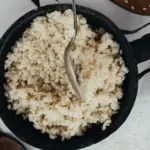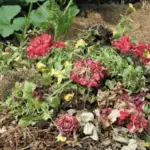Watermelons are a summer staple at BBQs and picnics. The delicious fruit also makes a healthy and refreshing snack on hot days. Even though watermelons are comprised primarily of water, they are still a good source of nutrients like Vitamins A and C.
While the fruit is edible, most people don’t snack on the rind. It’s hard to chew and relatively tasteless. Tossing watermelon rinds in the trash isn’t detrimental to your local landfill, but it does contribute to methane gas emissions.
Instead of throwing them in the garbage, you can put watermelon rinds in compost.

Can You Put Watermelon Rind in Compost?
You can compost watermelon rind. Your plants will appreciate the added nutrients, and so will your compost pile.
The rind is the whitish-colored portion of the watermelon between the fruit and thick greenish skin. You might also be surprised to learn that the rind is edible.
The tough, chewy portion is packed with vitamins and nutrients, but most people don’t take the time to cook or pickle the rind.
It’s time-consuming and doesn’t improve the flavor. It’s easier to put the rinds in your compost pile.
Did you know you can also compost watermelon skin? The process is the same for watermelon rinds and skin.

How to Compost Watermelon Rind
You can toss whole pieces of watermelon rind into compost, but it slows down the decomposition process.
To ensure the compost is ready for your garden, there are a few steps you should follow. It will also keep your compost healthy and discourage pests from nibbling on the rinds.
Does Watermelon Rind Go In the Green or Brown Composting Layer?
Compost piles are built using alternating layers of green and brown materials. Green materials are rich in nitrogen, while brown layers are high in carbon. Balancing the nutrient levels ensures a healthy pile with thriving microbes.
Green layers are comprised of plant waste, including kitchen scraps like watermelon rinds. The rinds are also high in moisture which is another ingredient for healthy compost.
Healthy compost piles are comprised of an equal mix of green and brown materials, combined with two parts moisture and oxygen.
Should You Cut Watermelon Rinds Before Composting?
Watermelon rinds are tough and can take a while to decompose. It can also disrupt the composting process.
Cutting the rinds into small pieces exposes more of the tough outer layer. It allows for faster decomposition. It also reduces the likelihood the rinds will attract rodents and other pests.

Tips on Composting Watermelon Rinds
Composting watermelon rinds only involves a few steps.
- Cut the rind into small pieces for faster decomposition
- Add to the green layer with other kitchen scraps
- Cover with a brown layer of material.
Your brown layer can contain everything from shredded newspaper and cardboard to twigs and dried leaves. The brown layer helps to absorb excess moisture than can upset the nutrient balance.
Don’t forget to aerate the pile every few days. The microbes need oxygen to compost the watermelon rinds.

How Long Does Watermelon Take to Decompose?
Watermelon rinds take around four to five weeks to decompose, but it also varies on the composting process.
Whole slices of watermelon rind take longer to decompose.
The microbes’ access to the tough rind is limited. It’s a good reason to cut watermelon rinds before composting.
Hot composting produces faster decomposition than cold compost piles. Watermelon rinds often decompose more slowly with cold composting.
Can You Compost Watermelon Seeds?
Composting watermelon seeds isn’t recommended. Some hot compost piles might be the exception, but most heaps can’t maintain a high enough temperature to kill watermelon seeds.
Seeds from the fruit can stick to the rind, resulting in new plants. The seeds rarely germinate in hot compost piles. When the internal temperature doesn’t kill the seeds, they can produce plants in the garden.
New plants can grow in cold compost from watermelon seeds. When allowed to mature, the seedlings can ruin the compost.
It’s usually not a good idea to compost watermelon seeds.

Can You Add Watermelon Rind to a Worm Bin?
Your red worms will love munching on watermelon rinds. It’s a favorite food source and it doesn’t take the wrigglers long to decompose the rind.
It’s best to cut the rind into small pieces. Your worms can only eat so much, and you don’t want the rind growing mold and bacteria.
Can You Add Watermelon Rind to Bokashi Compost?
Bokashi composting uses fermentation to decompose organic matter. You can put most of your kitchen scraps in a bokashi compost bin, including watermelon.
A good tip is to let the watermelon rinds dry out. You don’t want to add too much moisture to a bokashi composting bin. Excess moisture encourages bacteria growth. It’s why you should drain the bin regularly.
Are Watermelon Rinds Edible?
Watermelon rinds may look unappetizing, but they are edible. Most people pickle or cook the rinds before eating. It adds flavor and makes the rinds less chewy.
Even though most people find watermelon rinds unpalatable, they do contain vitamins and essential nutrients. The rinds contain potassium and Vitamin C.
Watermelon rind is also packed with antioxidants and citrulline. The fibrous rind is a surprisingly healthy food.

Can You Put Watermelon Rinds Down the Garbage Disposal?
It’s easy to think using your garbage disposal is better than throwing kitchen scraps away, but some items should never go down the sink drain.
Along with potato and banana peels, you don’t want to put watermelon rinds down the garbage disposal.
Watermelon rinds are fibrous. The stringy fibers often become wrapped around the blades. Freeing the blades often requires the help of a professional which can be expensive.
If you don’t have a compost pile, go ahead and toss the watermelon rinds in the trash.
Conclusion
You can compost watermelon rinds. The rinds go in the green layer and don’t forget to cut them into small pieces.
Composting watermelon rinds reduce methane gas emissions in landfills. It’s also a great way to add beneficial nitrogen to your garden.






